Counterpoint: Suspension
 Wednesday, December 31, 2008 at 10:31PM
Wednesday, December 31, 2008 at 10:31PM It's time to take a closer look at suspension. As I have mentioned in my Mario Melodies series on counterpoint, suspension is when elements/game ideas are offset from each other or when game elements travel across gameplay ideas/sections.
Examples of suspension can be found in most games. The three different types of suspension are as follows.
Abstract Suspension
Any game element that can be collected building up to a goal is probably a type of suspension. Take Super Mario Bros. coins for example. When you collect 100, you get a 1up. Because you can't collect 100 coins on any given level or in any single gameplay idea, the process of collecting coins to gain 1ups is suspended across the game. Once a coin is collected, it is added to the total, a number the value that is never reentered into the game world as a concrete/interactive element. For this reason, coins fall under the category of abstract suspension.
Other examples include
- Stock from the Super Smash Brothers series. In many other fighters, the victor is determined by whoever can win 2 out of 3 matches where each match is reset back to the starting conditions by manipulating the match clock, super meter, player health, and player positions. In Super Smash Brothers each stock represents a player life. So, in a 3 stock match for example, both players attempt to knock their opponents off the stage 3 times to win. When a player is knocked off the stage (ie. "killed") a stock is removed. If that player has any more stock, they'll reenter the match at full health. Because the opponent who survived doesn't get their health or position reset, they have to fight weakened and damaged. This means stage position, charged special moves, weakened attacks, and damage carry over for that player. Because the battle state is never completely reset, a new kind of interplay is created. I remember when I took a premature death from a Jigglypuff rest attack so I could reenter the match while Jigglypuff was sleeping and deliver a killing blow right back.
- Super Meters: Some fighters like Street Fighter III 3rd Strike allow players to build up their super meters during a round. Though the match is a best out of 3 event, when the round restarts everything is reset but the charge on both player's super meters (see video). Because the work put into these meters carry over between rounds, even a losing player of a round can build up super meter as a resource for the next match. When the meter carries over like this, players no longer fight 3 identical rounds. In a way, players fight one large round.
- Experience Points: EXP in RPG's and other games with leveling up systems are a type of suspension. Like coins, the work you put into the game to build exp gathers over time and across gameplay ideas, areas, and/or levels. Earning techniques and abilities in this way links what would otherwise be separate events/actions throughout the game. On a side note, attacks like poison, zombie, berserk, and having "knocked out" party members are a few examples of common RPG status effects that are suspended through the end of a battle encounter.
Character based (Power-up) Suspension
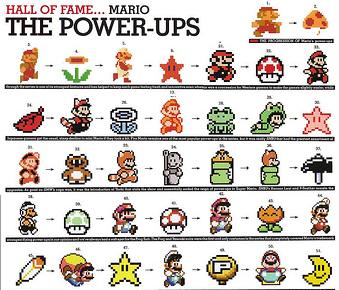
This one is easy. In Super Mario Brothers, all of the powerups create a type of suspension that is directly tied to the main character (Mario). When you grab a Mushroom, you become Big Mario taking your upgraded player state with you. Even in Super Mario Brothers, Mario's powerup state transfers between levels creating a level of persistence/suspension across the entire game. After all, it's possible to grab the first Mushroom in World 1-1 and beat the game without ever grabbing another powerup or getting hurt.
While this kind of suspension may seem obvious and commonplace, it's important to note that some games don't let you take your changed player state with you wherever you go. In Yoshi's Island, there are times when Yoshi transforms into a mole tank, helicopter, train, or a submarine. All of these powerup transformations are designed for players to use in specific areas/obstacle courses. Even if the player wanted to venture into areas that aren't designated for the transformations, the transformation can only be sustained for a limited time. Because of these design limitations, there is no suspension for these powerups. The powerups in Wario Land 4 and Wario Land: Shake it are similarly limited. Furthermore, the magic pickups in Crystal Chronicles and the weapon powerups in The Legend of Zelda: Four Swords are taken away after completing each level. This lack of suspension creates "procure on site" style gameplay.
Other good examples include.
- The Metroid series: Bombs, Missles, Hi Jump Boots, new suits, Super Missles, Grappling Beams, etc.
- The Mega Man series: The abilities Mega Man gains from defeated bosses.
- Resident Evil series: Guns, ammo, and other healing objects are carried around with the player.
Organic Suspension
The final and most interesting type of suspension is also the easiest type to understand. Organic suspension mainly applies to level elements and enemy elements. In Super Mario Bros. Goomba, Koopa, sliding shells, Mushrooms, 1ups, Starmans, etc. all have the ability to move between gameplay ideas as long as there aren't any obstacles in their way. Because the developers never designed any artificial walls for these elements, they simply do what they do best; move forward even if they cross over into another gameplay section. Yoshi from Super Mario World is an example of organic suspension. When startled, Yoshi will stampede away. As long as there aren't any pits for Yoshi to fall into, Mario can chase after Yoshi through the whole level. After completing the level, players are free to take Yoshi just about anywhere Mario can go including already visited stages.
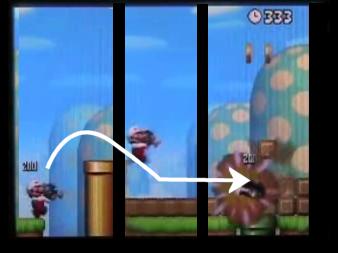
In New Super Mario Brothers, bob-ombs can be picked up and carried across the level for specific level transforming demolition work.
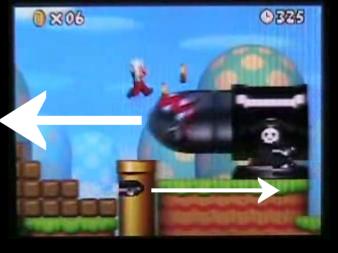
The white lines show how these bullet bills can travel with Mario. Because NSMB doesn't restrict forward and backward movement through the stages, it's possible to travel all the way back to the beginning of the level between two of these giant bullet bills.

It's possible to keep several of bullet bills on the screen at once. As long as they don't travel too far off screen, they're free to go where Mario goes.
For these reasons, World 7-5 is not only the best stage in New Super Mario Brothers, but it's also the best example of suspension for a single level encompassing abstract, character based, and organic suspension.
When an enemy or level object can move throughout a level without artificial restrictions, the potential for emergent possibilities increases greatly. Take the original Metroid for example.
The enemies in the stage follow and aim at Samus (the player character). Unlike in all of the subsequent Metroid games, the enemies in the original Metroid have the power to follow Samus through doorways, hurt, and even kill her while the player is unable to control. Players who want to live quickly learn to make sure the path is clear before entering doors. But the player in this video (skip to 6:30) used this enemy suspension potential to help him sequence break and speed run.

First, the player gets the enemy to follow Samus from the middle of this long room.

Then the player times entering the door so that the enemy follows into the next room creating suspension.
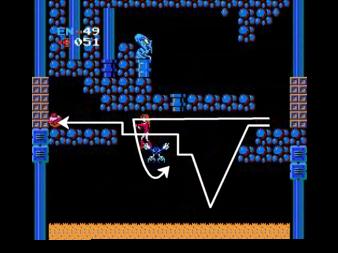
Then, in a perfectly executed maneuver, the player freezes the enemy, performs a mid air un-morph ball jump, lands on top of the frozen enemy platform, waits for the enemy to unfreeze propelling Samus into the area to the left. This incredibly emergent and deft move allowed the player to skip fighting two bosses thus shaving off lots of time.
When a game is more dynamic (ie. interplay, dynamic mechanics, transformative powerups), contrary motion and suspension does more for the overall game system. After all, what's the point of moving an enemy from one part of a level to another in an RPG ? One more battle of attack-attack-heal and it's like the enemy was never misplaced. You'll take your experience points, and move on. But in a game like Mario or Metroid, enemies are a part of tightly layered game systems where the powerups, interplay, and lines of contrary motion all work together.
The core feature of pure organic level design is suspension. In essence, pure organic level design can only be created in a game system designed so that the game elements react according to their forms and the elements aren't locked into specific areas by artificial boundaries. Many believe that open world games and physics based games are examples of pure organic design where players can go anywhere, do anything within their power, and revel in the dynamic, emergent outcomes. In actuality, I've found the "promise" of such games to be unfulfilled and greatly exaggerated. It doesn't take an open world to sustain organic and dynamic interactions. In the end, the richness of a game world is made up of all the individual design elements in a game, not the scope of its story, themes, or 3D world.
Still, physics based game system like the one in LittleBigPlanet are the closest we've come to experiencing pure organic levels. In LBP, the entire level is loaded up at once at the beginning. After that, everything exists persistently. Because everything reacts to the same physics based actions, the potential for emergence and suspension is very high. Take Improvisation #1 for example.
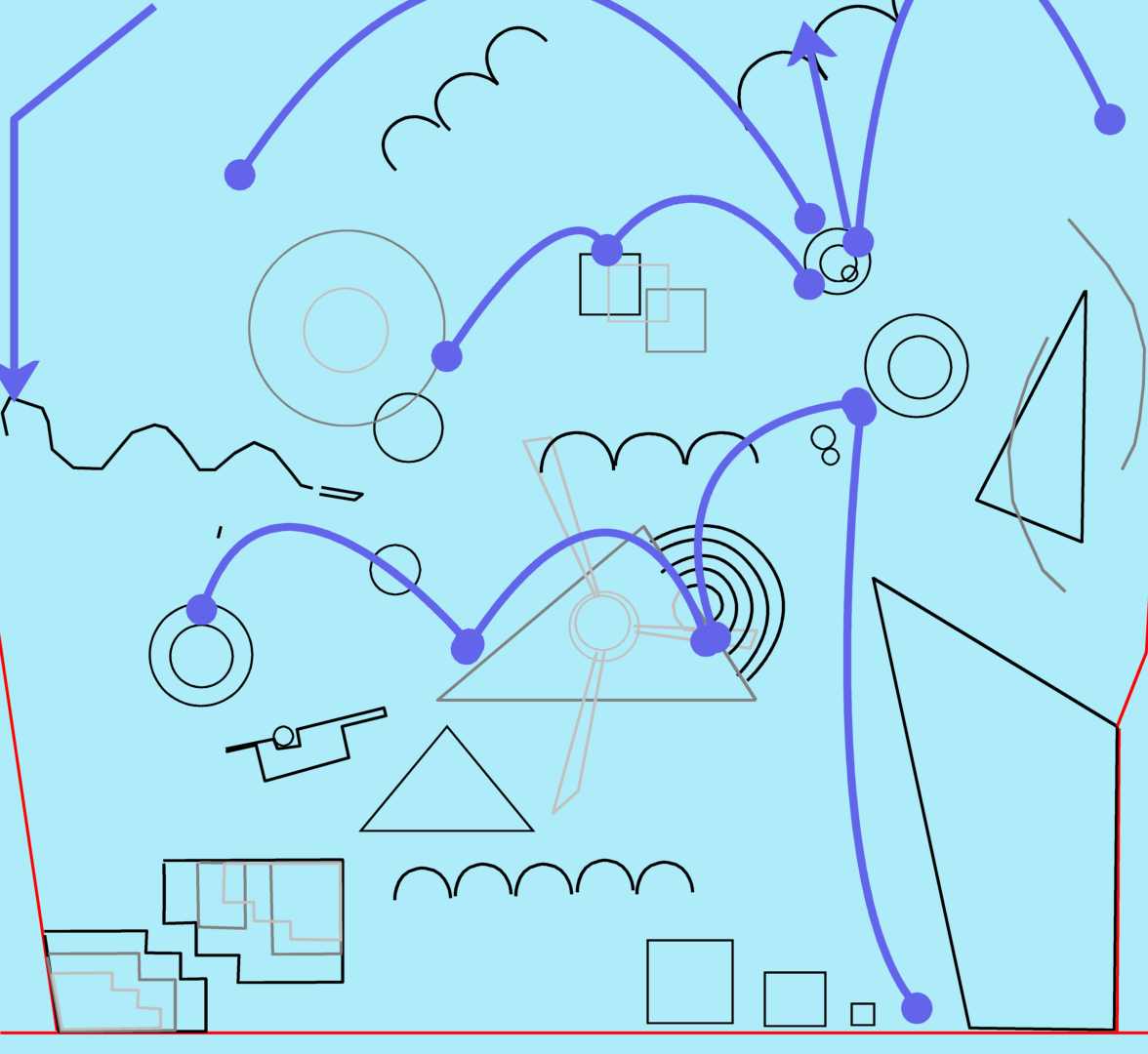
By grabbing onto the circle floaties that are emittied at the top, right side of the level, the player is able to travel around the stage in new ways. The floaters function as a temporary, external powerup like Yoshi from Super Mario World. By dragging a floater around the level, players can "fall with style" accessing new areas and secrets. Because the foater is a physical object in the level, it can be knocked and bounced around. If I designed this level so that it didn't use emitters that spawn objects into the game world, it would be one step closer to being a pure organically designed level.
Suspension... it's the interconnections that weave a gameworld together.



Reader Comments (1)
Nice points you've made.